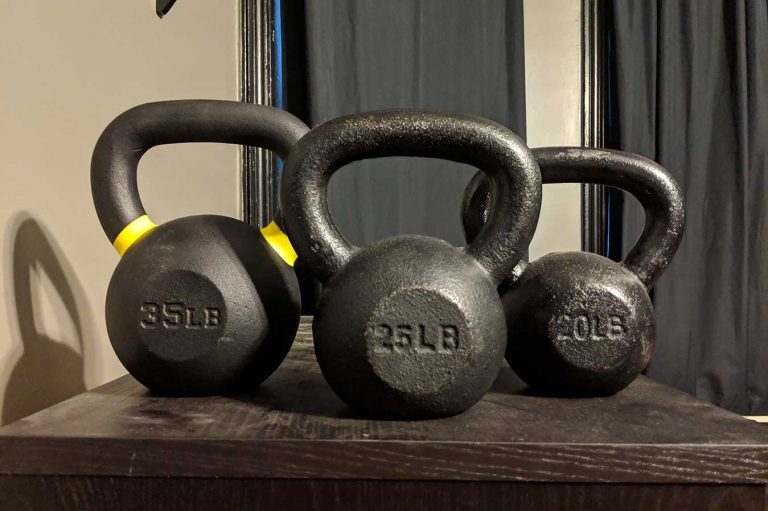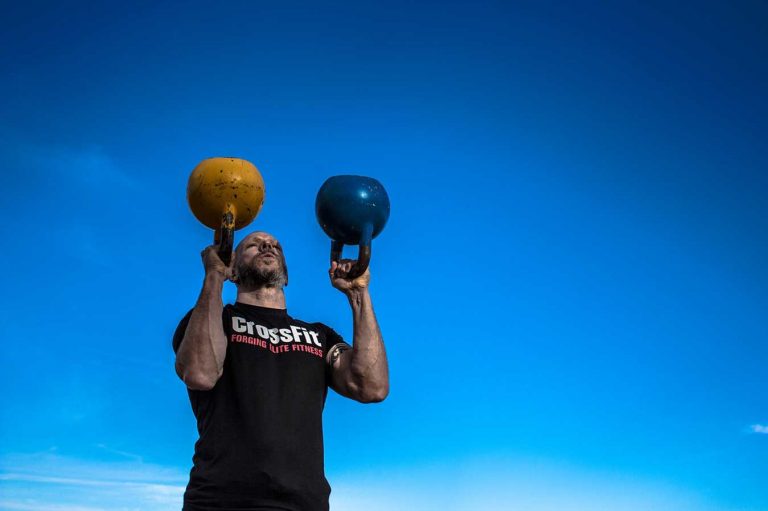I love the format of EMOM workouts because there are usually several ways to approach them. Short for Every Minute On The Minute, this type of workout requires the completion of a task within 1 minute. The quicker that task is finished the more rest time before the next round. When it comes to kettlebells, EMOMs typically feature several different exercises counting as reps in a set. Since many kettlebell exercises have variations one may opt for a particular style.
In most cases, the quicker variation of an exercise is more taxing on the body whereas the longer variation isn’t such a drain. Using this knowledge, a person might want to go all out during the EMOM and have a longer rest period at the end of each round. However, such a strategy could backfire and make the final few rounds a real challenge. That’s not to say that going the easier route will reduce fatigue either. There are several factors to consider.
How To Approach This EMOM Kettlebell Workout
Before I get into specifics, let’s go over the sequence for this EMOM workout. It sounds easy enough on paper but you’d be surprised how exhausting it is once completed. None of the kettlebell exercises are overly complicated. So beginners should have no problem executing the moves. The video below shows one round of the EMOM.
EMOM Set In Order
- One-arm swing (3x) to
- One-arm snatch (3x) to
- Overhead reverse lunge (3x)
- Switch hands and repeat the above list in order
When performed, the above set should take anywhere from 45 to 50 seconds to get through. I recommend going 10 rounds (10 minutes). Why so short? Obviously, there isn’t a lot of time to recuperate before the next round begins. Eventually, the exercises will become a grind – especially doing all of those overhead reverse lunges.
Doing the math, 10 sets of this routine yields a grand total of 180 reps. I’ve designed it so that each subsequent exercise is easily transitioned to the next. Efficiency is key to getting the most rest time possible. However, you never want to rush through an EMOM and sacrifice technique. Instead, consider which weight you should use for this workout.
Deciding On What Kettlebell Weight
Which weight is right for you is relative to your comfort level. I consider 35 lbs. to be my go-to weight for most of my workouts. It’s my standard size. Others may consider this too light or too heavy. With that being said, I wouldn’t go above YOUR standard weight for this EMOM. Trust me, it’s tough enough and there is no need to go heavy. Balancing during the overhead reverse lunges requires some stamina so don’t overdo it!
Personally, I use either my 35 lb. or 25 lb. kettlebell depending on how my body is feeling that day. Even at a lighter size, this is still a great cardio workout. For folks that want a longer workout, use a lighter bell and extend to 12-15 rounds. If you want more of a challenge with longer rest periods, then keep reading.
Try These Variations of Popular Exercises
As I’ve learned over the past few years, there’s a generalized term for many kettlebell exercises. If someone were to ask instructors and enthusiasts to demonstrate a kettlebell swing, there’s a good chance you’d see different styles. Unfortunately, many people out there will chime in and say it is being done wrong because it is not their version. For this to be true a more defined name must be used.
Kettlebell Swing
Purists will say that the Russian hip-hinge kettlebell swing is the only variation that matters. I certainly enjoy its benefits as it requires explosive power from the hips. The fast action of the hip-hinge swing means you can complete reps in a quick fashion. Those saved precious extra seconds will allow for more rest time in the EMOM. The downside is that it requires more energy which will lead to fatigue sooner.
An alternative to the hip hinge swing that requires less energy is the pendulum or sport swing. Many athletes utilize this variation during timed competitions to preserve as much strength as possible. Now you may think that doing only 3 swings at a time isn’t that taxing. Although, when you add up every swing in 10 rounds [(3L + 3R) x 10] that’s 60 total swings. Certainly not an overwhelming amount but when you throw in the lunges and snatches the swing style makes a difference.
Since the trajectory with the pendulum swing is more upward than outward like the hip-hinge, this does benefit the transition into snatch. Check out this article comparing the two which shows a side-by-side slow motion of each. Seasoned kettlebellers may even perform the pendulum swing almost as quickly as the hip-hinge. For the rest of us, that loss of time could lead to a quick turnaround to the next round.
Kettlebell Snatch
The same initial mechanics apply to the snatch as well. Hip hinge or pendulum motion to begin – your choice. However, for the purpose of this workout, I’m more so referring to whether a half-snatch or full-snatch is appropriate. The difference between the two is that in a full snatch the bell is dropped straight down after lockout. A half snatch has you put the kettlebell in the rack position briefly and then proceed to lower the bell.
The extremely short rest in rack literally allows you to catch your breath before continuing. It also gives the muscles temporary relief. You’ll lose time at the end of the set of course. One way to think about it is that perhaps having a shorter rest period isn’t such a bad thing. You’ll still probably get at least 5 to 10 seconds and the heart rate will remain elevated longer. There really is no right or wrong way to approach this workout with different variations.
Final Thoughts On This EMOM Kettlebell Workout
Doing 9 exercises on one side of your body before switching should take somewhere between 20 to 25 seconds. That’ll give at least 30 seconds of rest on that side before repeating the round. The hardest, of course, is the overhead reverse lunge. Your arms, upper body, and core really shouldn’t feel too strained. Rather, it’s your legs that will most likely tire out. Make sure you time your breathing appropriately too since there is so little rest time.
It’s always a good idea to keep a lighter weight on standby should you choose to work out with your regular kettlebell. That way you can switch out after any round without having to cut the workout short. If you need an app to cue you on every minute I recommend GymNext’s Flex Timer. Available for Android and IOS, it has a variety of options to program your workout for rest and breaks.




